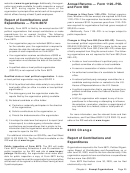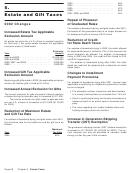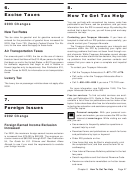Publication 553 - Highlights Of 2002 Tax Changes Page 20
ADVERTISEMENT
For years beginning after 2001, a defined contribution
Volume Submitter Plans). The request should be filed with
plan’s maximum annual contributions and other additions
Form 8717, User Fee for Employee Plan Determination
(excluding earnings) to the account of a participant in-
Letter Request, and the appropriate user fee if the fee
creases to the lesser of the following amounts.
applies (see User Fee, next).
•
100% of the compensation actually paid to the par-
User Fee
ticipant.
•
$40,000 (subject to cost-of-living increases after
The user fee for requesting a determination letter does not
2002).
apply to certain requests made after 2001 by an eligible
employer. An eligible employer is one who has 100 or
fewer employees who received at least $5,000 of compen-
Excise Tax for Nondeductible (Excess)
sation from the employer during the preceding year. At
Contributions
least one of them must be a non-highly compensated
employee participating in a qualified plan. For more infor-
For years beginning after 2001, in figuring the 10% excise
mation, see User fee under Setting Up a Qualified Plan in
tax, you can choose not to take into account as nondeduct-
chapter 4 of Publication 560.
ible contributions for any year contributions to a defined
benefit plan that are not more than the full funding limit
Simplified Employee Pensions (SEPs)
figured without considering the current liability limit. Apply
the overall limits on deductible contributions first to contri-
For years beginning after 2001, the following changes
butions to defined contribution plans and then to contribu-
apply to SEPs. For more information, see Publication 560,
tions to defined benefit plans. If you use this new
Retirement Plans for Small Business.
exception, you cannot also use the exception under sec-
tion 4972(c)(6) of the Internal Revenue Code.
Deduction Limit Increased
Involuntary Payment of Benefits
The maximum deduction for contributions to a SEP is
increased to 25% of the compensation paid or accrued
A qualified plan may provide for the immediate distribution
during the year to your eligible employees participating in
of a participant’s benefit under the plan if:
the plan.
•
The participant’s employment is terminated, and
Elective deferrals under a SARSEP (discussed later)
•
are not subject to this deduction limit. However, the com-
The present value of the benefit is not greater than
bined deduction for a participant’s elective deferrals and
$5,000.
other SEP contributions cannot exceed $40,000. Also,
elective deferrals are not taken into account when figuring
For distributions made after 2001, benefits attributable
the amount you can deduct for employer contributions that
to rollover contributions and earnings on the contributions
are not elective deferrals.
can be ignored in determining the present value of these
Compensation for figuring the deduction for employer
benefits.
contributions includes elective deferrals under a SARSEP.
For distributions made after the Department of Labor
adopts final regulations implementing rules on fiduciary
responsibilities relating to this provision, a plan must pro-
Contribution Limit Increased
vide for the automatic rollover of any distribution of more
than $1,000 to an IRA under this provision, unless the
The annual limit on the amount of employer contributions
participant chooses otherwise. The plan administrator
to a SEP increases to the lesser of the following amounts.
must notify the participant in writing that the distribution
•
25% of an eligible employee’s compensation.
can be transferred to another IRA.
•
$40,000 (subject to cost of living adjustments after
2002).
Plan Amendments To Conform to the
Economic Growth and Tax Relief
Elective Deferral (SARSEPs) Limit
Reconciliation Act of 2001 (EGTRRA)
The limit on elective deferrals for participants in SARSEPs
Generally, master and prototype plans are amended by
will increase, and participants who are age 50 or older at
sponsoring organizations. However, you may need to re-
the end of the plan year may be able to make catch-up
quest a determination letter regarding a master or proto-
contributions. For information about the new limit and
type plan you maintain that is a nonstandardized plan if
catch-up contributions, see Elective Deferrals (401(k)
you make changes to adopt some provisions enacted by
Plans) under Qualified Plans, earlier.
EGTRRA. Your request should be made on the appropri-
ate form (generally Form 5300, Application for Determina-
tion for Employee Benefit Plan, or Form 5307, Application
Compensation limit. The maximum amount of an
for Determination for Adopters of Master or Prototype or
employee’s compensation you can consider when figuring
Page 20
Chapter 3 IRAs and Other Retirement Plans
ADVERTISEMENT
0 votes
Related Articles
Related forms
Related Categories
Parent category: Financial
 1
1 2
2 3
3 4
4 5
5 6
6 7
7 8
8 9
9 10
10 11
11 12
12 13
13 14
14 15
15 16
16 17
17 18
18 19
19 20
20 21
21 22
22 23
23 24
24 25
25 26
26 27
27 28
28 29
29 30
30 31
31








